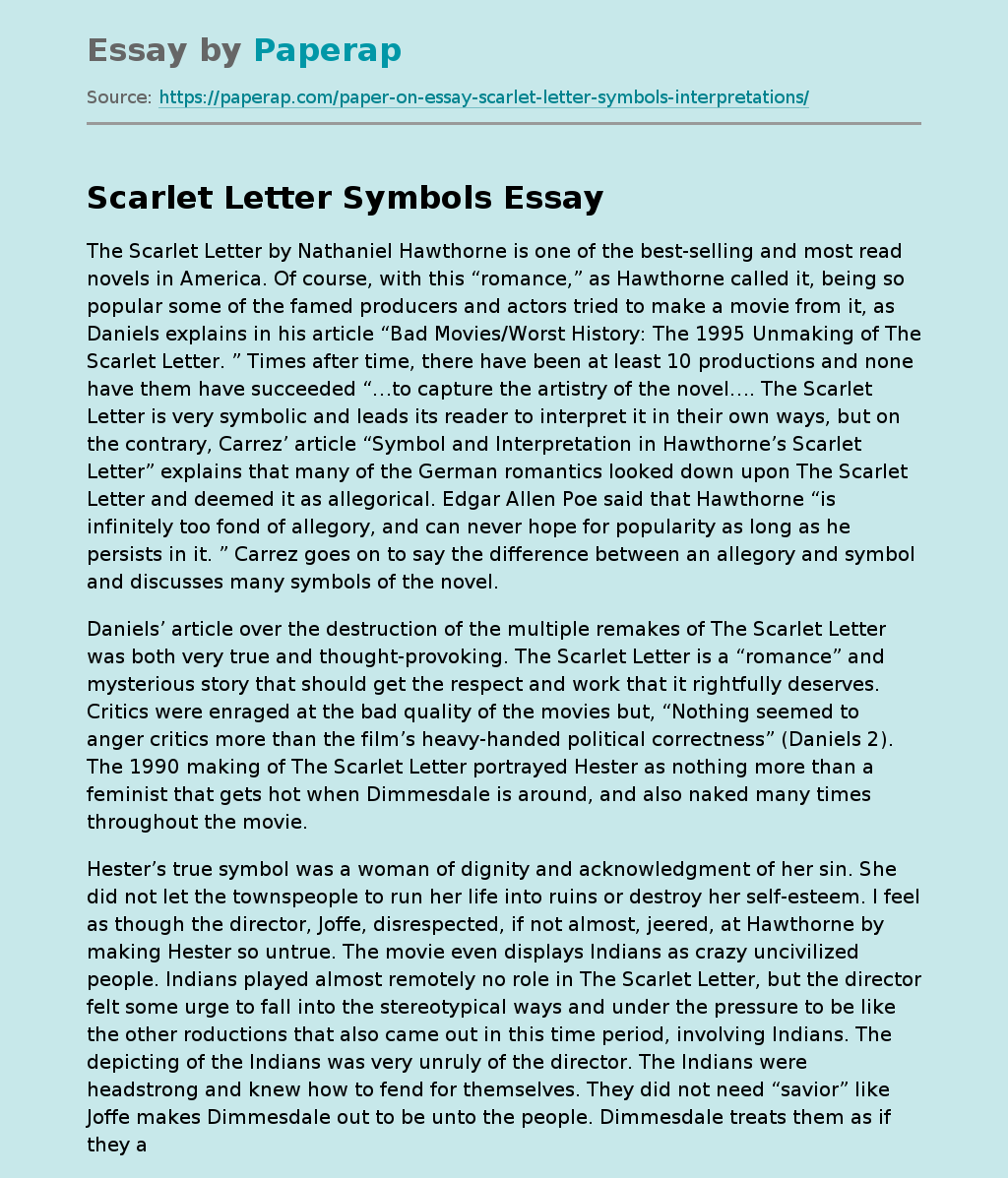Scarlet Letter Symbols
The Scarlet Letter by Nathaniel Hawthorne is one of the best-selling and most read novels in America. Of course, with this “romance,” as Hawthorne called it, being so popular some of the famed producers and actors tried to make a movie from it, as Daniels explains in his article “Bad Movies/Worst History: The 1995 Unmaking of The Scarlet Letter. ” Times after time, there have been at least 10 productions and none have them have succeeded “…to capture the artistry of the novel….
The Scarlet Letter is very symbolic and leads its reader to interpret it in their own ways, but on the contrary, Carrez’ article “Symbol and Interpretation in Hawthorne’s Scarlet Letter” explains that many of the German romantics looked down upon The Scarlet Letter and deemed it as allegorical. Edgar Allen Poe said that Hawthorne “is infinitely too fond of allegory, and can never hope for popularity as long as he persists in it. ” Carrez goes on to say the difference between an allegory and symbol and discusses many symbols of the novel.
Daniels’ article over the destruction of the multiple remakes of The Scarlet Letter was both very true and thought-provoking. The Scarlet Letter is a “romance” and mysterious story that should get the respect and work that it rightfully deserves. Critics were enraged at the bad quality of the movies but, “Nothing seemed to anger critics more than the film’s heavy-handed political correctness” (Daniels 2). The 1990 making of The Scarlet Letter portrayed Hester as nothing more than a feminist that gets hot when Dimmesdale is around, and also naked many times throughout the movie.
Hester’s true symbol was a woman of dignity and acknowledgment of her sin. She did not let the townspeople to run her life into ruins or destroy her self-esteem. I feel as though the director, Joffe, disrespected, if not almost, jeered, at Hawthorne by making Hester so untrue. The movie even displays Indians as crazy uncivilized people. Indians played almost remotely no role in The Scarlet Letter, but the director felt some urge to fall into the stereotypical ways and under the pressure to be like the other roductions that also came out in this time period, involving Indians. The depicting of the Indians was very unruly of the director. The Indians were headstrong and knew how to fend for themselves. They did not need “savior” like Joffe makes Dimmesdale out to be unto the people. Dimmesdale treats them as if they are almost slaves, revealed in these lines:” You are free my people, go back into the forest. ” Once again, the director is disrespecting Hawthorne and the seriousness of his work.
Symbols In Scarlet Letter
I believe that if Joffe were to put the Indians in the movie he should have at least gave them the proper respect they deserved as dignified people. Daniels argues that many of the scenes from the movie are stolen from other movies of that time. Though I am not familiar with these movies, I do agree that an attempted rape scene is absurd for a story of this quality. The director is basically saying that Hawthorne’s book did not have enough action or “spunk” so he added in this.
I think that because The Scarlet Letter is enriched and filled with symbols, and that alone should be captivating enough for a movie. Not to mention in the end of the movie, Hester, along with Dimmesdale and Pearl ride on a buckboard to a new life in a different town. This doesn’t happen in The Scarlet Letter, but of course the director needed to succumb to the trend of Disney channel-like endings, where everything works out in the end. Daniels stresses the fact that the movie needed to display Dimmesdale death and the tragedy of his burdens.
I think that Dimmesdale dying because of his illness is a big turnout of The Scarlet Letter. Dimmesdale deserved his death almost because of his cowardice ways of not wanting to risk his reputation and confess his sins to the townspeople. Though there were many god-awful mistakes in the movie remake of The Scarlet Letter, The director maybe did not fully understand the symbols or see them for what they were supposed to be. Everything from, the setting described in Hawthorne’s book, to the people and what they said, was filled with symbols and meanings.
Carrez further explains symbols and what their true meanings are. Many critics argue and true to decipher over and over again if The Scarlet Letter has “true” symbols. However, I am indifferent about Carrez’ work in this article. She seems to be noticing and commending Hawthorne for his artistic value and ability to force his readers to think and get engaged in his writing, he causes them to decide their own thoughts and feelings towards the characters.
On the other hand, Carrez questions Hawthorne’s style along with if he is right in his ways. She brings in the facts of the Bible, “… Hawthorne leans towards a romantic conception of symbol, which entails a multiplication of subjective truths. However, the question of symbol is bound to be set against that of understanding the Bible in a society impregnated with religious feelings. ” I feel as though Carrez was also confused on the meaning of symbols and whether she should agree or disagree with most critics.
Scarlet Letter Symbols. (2019, Dec 05). Retrieved from https://paperap.com/paper-on-essay-scarlet-letter-symbols-interpretations/

